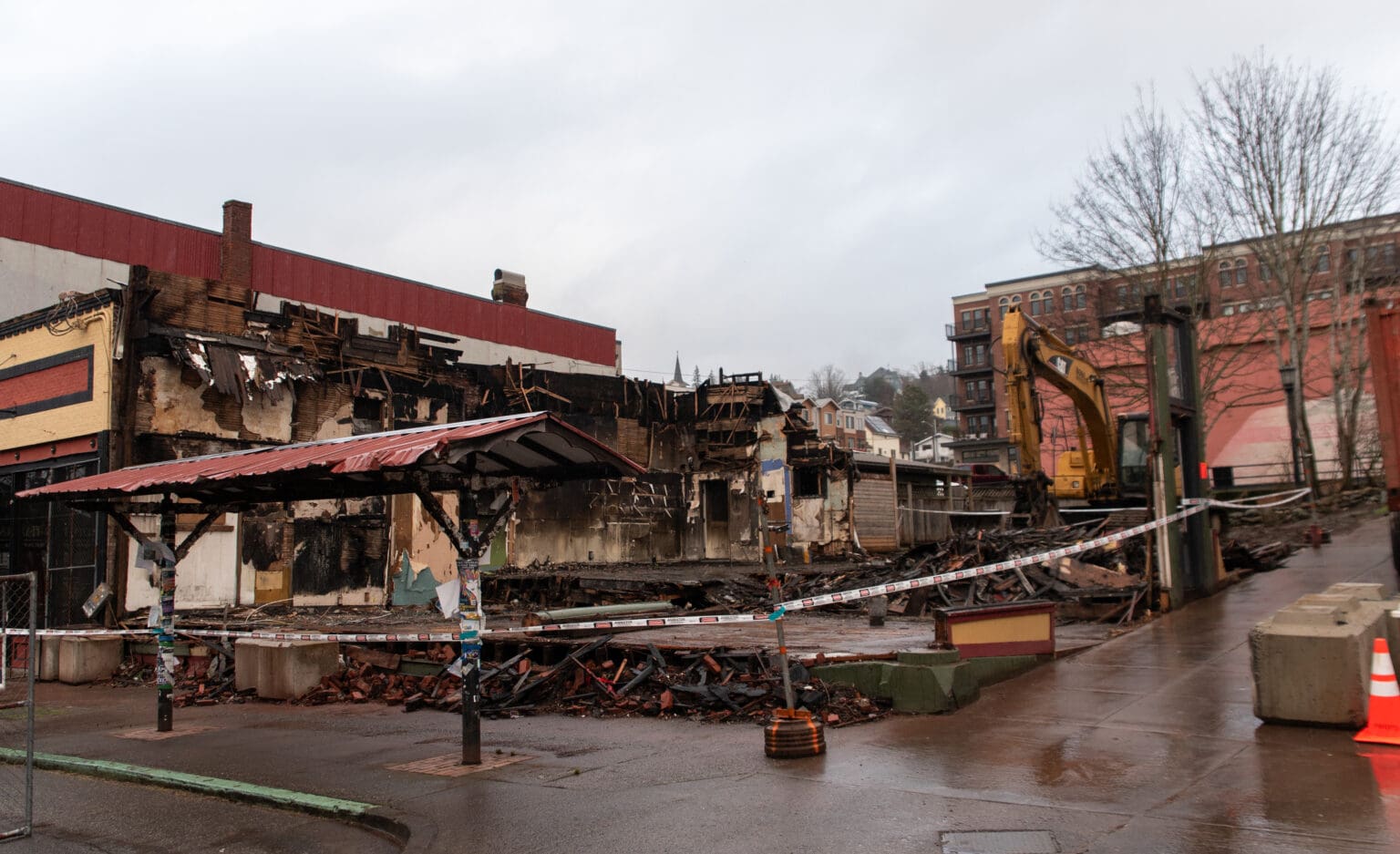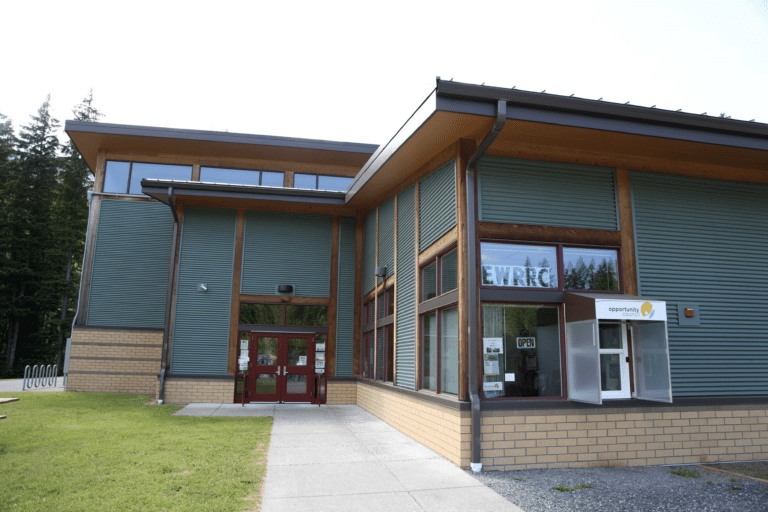Fires in two historic Bellingham buildings within weeks, one fatal, have sharpened the public focus on safety inspections and fire codes in Bellingham, even though both structures were considered code compliant.
City records show neither of the century-old buildings, Fairhaven’s Terminal Building and the structure housing State Street Bar, had been inspected by city fire officials since 2018. No regulations exist requiring more-frequent inspections, Bellingham Fire Chief Bill Hewett told Cascadia Daily News.
How often an existing building is inspected is largely determined by critical need and investigators’ availability.
Hewett said increasing demands on the city’s four-person Fire Marshal’s Office have impacted the frequency of inspections. The team oversees compliance permitting for new buildings, in addition to conducting fire inspections and fire investigations. Existing building fire code inspections, unlike investigations and permitting, don’t have strict deadlines.
The 135-year-old Terminal Building was also not equipped with a fire alarm system, sprinklers nor smoke detectors, fire investigator Shawn Linville told CDN in December. The only required safety equipment was a fire suppression unit in the kitchen of the Harris Avenue Cafe, which was installed and code-compliant at the time of the fatal fire on Dec. 16, according to city records.
No records exist for such a system in the kitchen of the State Street Bar, where a fire started in a fryer on Jan. 3. The Bellingham fire inspector in charge of the site said that while a portable hood system was present, it was installed without the proper permits.
In the late-night Fairhaven fire, cafe owner Nate Breaux, 39, died of smoke inhalation, according to the Whatcom County Medical Examiner’s office. His body was not found for 10 days.
The cause of that fire remains under investigation. However, the expedited efforts to search for victims might ultimately end up hampering the team’s ability to ever fully determine the fire cause, Hewett said, noting that under different circumstances, investigators would have been more meticulous in preserving scientific evidence.
Hewett said that nothing about either of the recent fires would require changing the city’s fire code. But he said he has concerns about the workload being shouldered by the city’s dedicated fire marshal and team of three fire inspectors.
“The county kind of went through the same thing that the city has gone through, where building has outpaced staffing,” Hewett said, recalling his previous nine years with the Whatcom County Fire Marshal’s Office, during which he conducted existing building inspections.
Bellingham Mayor Kim Lund did not respond to a request for comment.
City records show that both buildings were slated to be revisited by fire officials in 2020, but the inspections did not occur.
“Looks like we had them on a two-year cycle,” Hewett said, reviewing the documents.
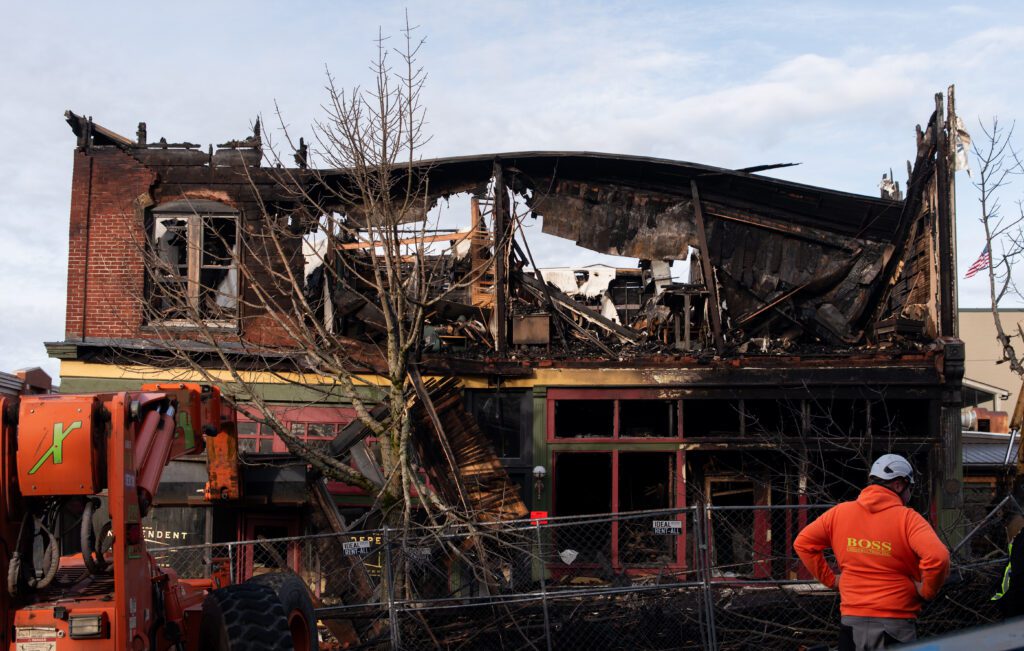
The ground floor of the Terminal Building housed the Harris Avenue Cafe and The Old Independent Coffeehouse. The second floor contained nine offices with 12 tenants, mostly mental health and massage therapists. The building, damaged beyond repair, has been largely demolished.
Jim Hestad, co-owner of the historic structure, declined to speak to CDN for this story, saying that he was processing the tragedy.
Untangling fire code
Fire code compliance can be complex.
In existing buildings, determining what fire safety precautions are necessary relies heavily on usage, occupancy and what codes were in place at the time of construction. Retroactive requirements outlined in the code vary widely depending on the building.
Ensuring a building is compliant with code is often a shared responsibility between business owners and building owners.
There are no laws in Bellingham — or the state — outlining how often fire officials need to conduct inspections of existing buildings. Hewett explained that the risk associated with the use of a building is a significant factor for how often a structure should be reviewed.
For example, a chemical manufacturing plant that has a very high fire hazard would ideally be inspected every six months. A structure considered low risk could go years without the need for inspection.
“The reality of it is that those intervals are also based on the availability of an inspector,” Hewett said.
With construction in Bellingham booming and the complexity of the structures increasing, fire officials have had less time for the inspection of existing buildings, Hewett said.
“We are seeing more of these mixed-use occupancies where we have multiple floors of residential over a floor commercial,” he explained.
In decades past, firefighters would have helped with less complicated fire inspections. However, increased call volume levels are keeping them busy, Hewett said.
He explained that these inspections are usually focused on identifying any electrical hazards, ensuring exits are unobstructed and that fire safety systems are being maintained, as well as any specialty hazard associated with how the building is being used.
Sprinkler systems, fire alarms and other fire suppression systems are required to be checked by certified third-party vendors at regular, predetermined intervals outlined in the fire code. These are then submitted to the fire marshal’s office.
The goal is not to shut businesses down, but to ensure that business owners and property owners are in compliance, Hewett said.
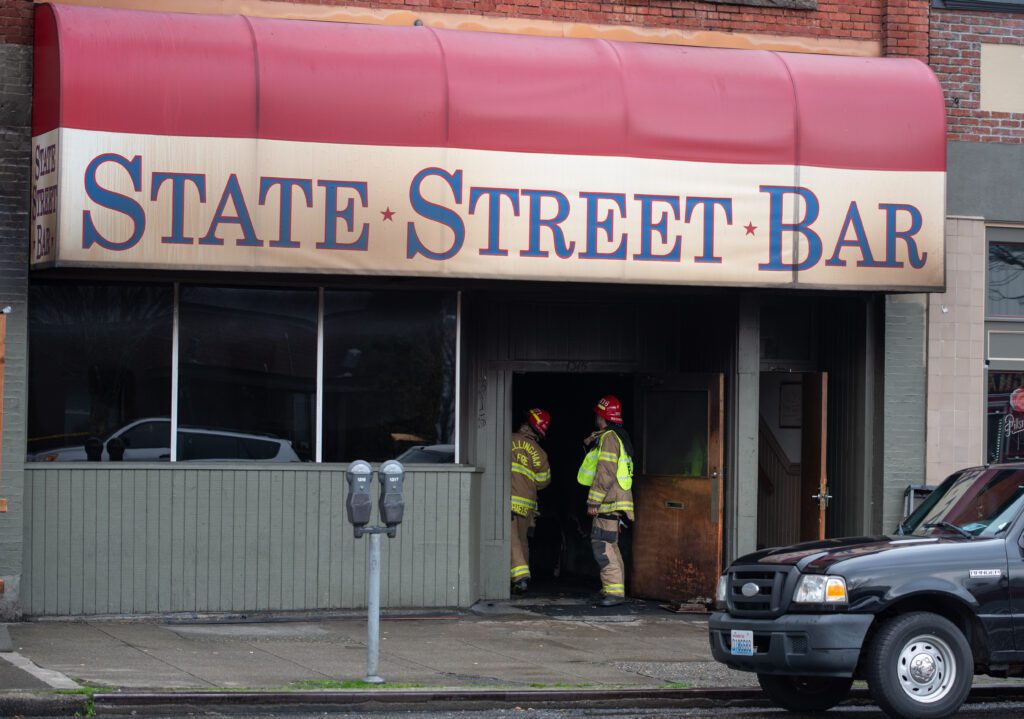
Building construction date, usage, occupancy and size are the primary factors weighed when determining what fire safety precautions are needed for a building to be in compliance with code.
“The code is trying to wrestle those two factors: how safe is the building itself, and how risky is the occupancy,” said Marilyn Kaplan, a practicing architect specializing in historic preservation and the application of building and fire codes to these buildings. She serves on existing building committees of the International Code Council and is the author of an upcoming Preservation Brief on codes to be published by the National Park Service.
Fire code changes and risk level
Local fire departments responded to about 1.5 million fires in the U.S. in 2022, according to estimates by the National Fire Prevention Association. These fires killed 3,790 people and caused an estimated $18 billion in property damage.
“These statistics represent our culture’s acceptance of the level of risk we’re willing to take on by occupying buildings, whether they be new buildings or old buildings,” Kaplan said.
However, Kaplan pointed out that in a situation where a community has experienced an alarming or unacceptable level of loss, it would be wise to review fire code, retroactive provisions and related local ordinances to see whether or not they meet the community’s needs.
When deemed necessary, fire code can change — sometimes in significant ways. The Station nightclub fire in Rhode Island, which left 100 people dead in 2003, is one such example. After the fire in the repurposed historic building, sprinkler systems became mandatory in any establishment — no matter when it was built — functioning as a nightclub.
The 2012 Bellingham marina fire that killed two and caused millions in damage led to the city updating its fire code. Some of those changes were ultimately adopted by the international code, Hewett said.
Bellingham operates under the 2018 International Fire Code, which is part of a suite of codes — including building codes — adopted and amended by the state. Updates to the model code are released every three years by the International Code Council, which is composed of a wide range of subject experts.
The Washington State Building Code Council adopts the fire code for the state. All other jurisdictions must adopt the one selected by the council, though they can amend it. The council has delayed the adoption of the 2021 International Fire Code multiple times. It is expected to take effect later this year.
“Each jurisdiction can make it more restrictive; they can’t make it less restrictive than what the state minimum is,” said Tom Maloney, president of the Washington State Association of Fire Marshals.
The association has more than 700 fire prevention specialists from four states, due to the organization moving to an online platform that includes monthly webinars for continuing education credit, Maloney explained.
The code being used in Washington is the same used in most states, as well as a number of foreign countries, said Will Anderson, a fire inspector with the Whatcom County Fire Marshal’s Office.
“In a historic building, you don’t get to play with it unless they upgraded or changed something,” Anderson said. “An obvious example of this would have been if the second floor of the Terminal Building, permitted for business use, was turned into residential housing.”
Current code requires any residential space to have smoke detection, including residential space attached to commercial space, Hewett explained. Additionally, these multi-family and mixed-use occupancies could require sprinkler systems depending on the occupancy load of the building.
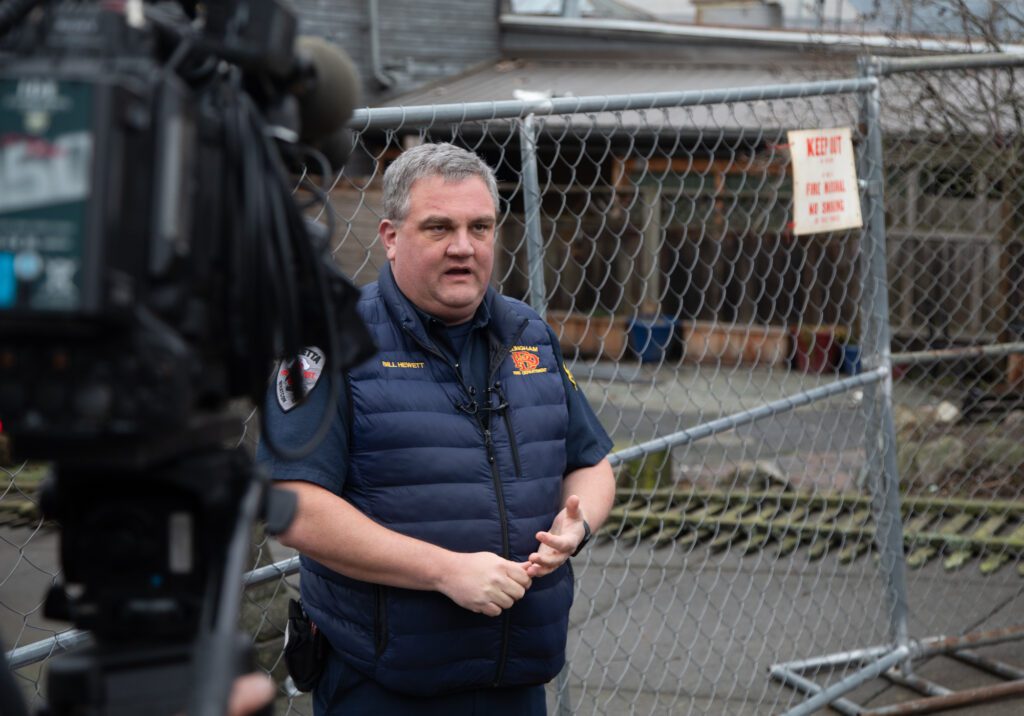
Nothing in the city’s code would have retroactively required sprinklers, fire alarms or smoke detectors at the Terminal Building, Hewett confirmed.
“If you built the exact same occupancy today, it would probably have the exact same requirements,” he said.
Fire safety in historic buildings
Addressing fire safety in historic buildings comes down to finding the right balance between safety and preserving the cultural and architectural value of the building, fire researchers said.
No statistical records are available for the number of historic buildings lost or damaged by fire every year, according to a report by Jack Watts, a national fire safety specialist.
Yet these buildings play a vital role in communities like Bellingham, drawing in both tourists and anchoring residents with a sense of place, said Whatcom Museum Archivist Jeff Jewell.
“It’s nice to have a place that is shared with generations gone and generations coming,” Jewell said. “That continuity of time, that’s an important thing.”
Bellingham has lost three historic buildings to fire in the past four years including the iconic, 135-year-old Terminal Building, which was the oldest, continually occupied building in the Fairhaven district and on the National Register of Historic Places.
In 2019, the Spokane Block, the oldest building on Railroad Avenue at the heart of Bellingham, was engulfed in flames. Hohl Feed and Seed, and the pets inside, were lost.
“That building burned once in February and then it burned again a few months later, and that took out the rest of the block,” Jewell said.
The second fire burned through the building that housed Clark Feed and Seed and Avalon Records, which was built in 1908.
“That was a major hit on historic Bellingham,” Jewell said.
The destruction of historic buildings by fire or demolition is a loss for the whole community, Jewell said.
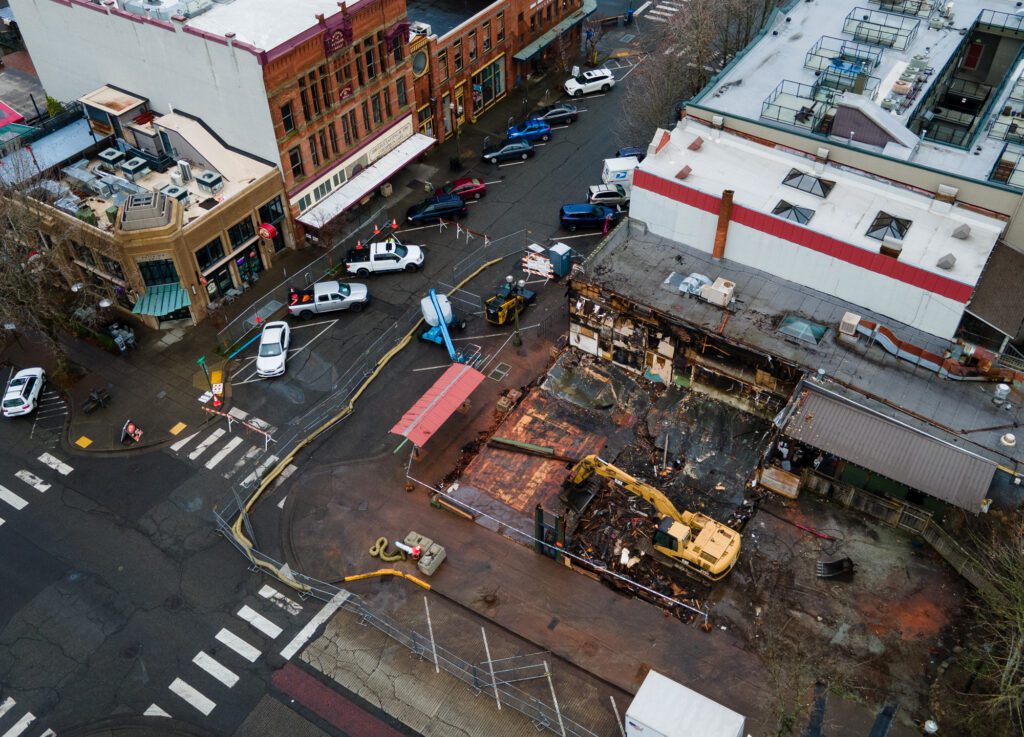
“The first thing you do in preserving a building is eliminate threats,” said Michael Sullivan, a public historian who founded a studio about 25 years ago that specialized in commercial and public landmarks, as well as historic buildings. “A fire prevention system is pretty critical to the way you think about buildings.”
Kaplan noted that there is a little more flexibility around how fire codes are enforced in designated historic buildings to preserve the elements of what makes such a building historic.
It comes down to “looking for an alternate approach to finding an equivalent or acceptable level of fire safety,” she said.
Maloney, who is also the assistant fire chief/marshal for the Marysville Fire District, noted that the historic opera house in Marysville was retrofitted with an expensive sprinkler system four years ago.
Though modern fire code has placed an increased emphasis on sprinkler systems and other active fire prevention systems, experts say that in many cases, such financial undertakings aren’t viable — or necessary.
Sullivan said many historic buildings were constructed with fire-resistant materials, such as brick and stone, as an alternative to the wood-framed commercial buildings that were common in the Pacific Northwest in the late 1800s.
“In historic buildings, the most common concerns are whether existing doors and stairs are an acceptable means of egress and whether the marking and illumination of exits is adequate,” wrote expert Watts in his booklet “Fire Safety in Historic Buildings.”
These are issues that can be addressed during operational fire code inspections, Hewett said. In cases where exits are blocked, business owners are required to either immediately address the issue or face being shut down.
Hewett said that during the last couple of years in Bellingham, existing building inspections have become less routine and done more often in response to known hazards.
“If there’s a known violation out there, they would prioritize that,” he said.
“It does concern me,” Hewett said of the more reactionary response to existing building inspections. “We’re working on a plan to try and be more involved.”
Reporter Ralph Schwartz contributed to this story.
Reach Isaac Stone Simonelli at 360-922-3090 ext. 127 or isaacsimonelli@cascadiadaily.com.

